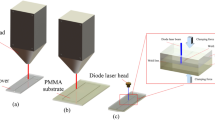Abstract
The glass-based microfluidic chip has widely been applied to the lab-on-a-chip for clotting tests. Here, we have demonstrated a capillary driven flow chip using the water-assisted CO2 laser ablation for crackless fluidic channels and holes as well as the modified low-temperature glass bonding with assistance of adhesive polymer film at 300°C. Effect of water depth on the laser ablation of glass quality was investigated. The surface hydrophilic property of glass and polymer film was measured by static contact angle method for hydrophilicity examination in comparison with the conventional polydimethylsiloxane (PDMS) material. Both low-viscosity deionized water and high-viscosity whole blood were used for testing the capillary-driving flow behavior. The preliminary coagulation testing in the Y-channel chip was also performed using whole blood and CaCl2 solution. The water-assisted CO2 laser processing can cool down glass during ablation for less temperature gradient to eliminate the crack. The modified glass bonding can simplify the conventional complex fabrication procedure of glass chips, such as high-temperature bonding, long consuming time and high cost. Moreover, the developed fluidic glass chip has the merit of hydrophilic behavior conquering the problem of traditional hydrophobic recovery of polymer fluidic chips and shows the ability to drive high-viscosity bio-fluids.









Similar content being viewed by others
References
G. Allcock, P.E. Dyer, G. Elliner, H.V. Snelling, Experimental observations and analysis of CO2 laser-induced microcracking of glass. J. Appl. Phys. 78, 7295–7303 (1995)
A. Baram, M. Naftali, Dry etching of deep cavities in Pyrex for MEMS applications using standard lithography. J. Micromechanics Microengineering 16, 2287–2291 (2006)
A. Ben-Yakar, A. Harkin, J. Ashmore, R.L. Byer, H.A. Stone, Thermal and fluid processes of a thin melt zone during femtosecond laser ablation of glass: the formation of rims by single laser pulses. J. Phys. D 40, 1447–1459 (2007)
S. Bouaidat, O. Hansen, H. Bruus, C. Berendsen, N.K.B. Madsen, P. Thomsen, A. Wolff, J. Jonsmann, Surface-directed capillary system; theory, experiments and applications. Lab Chip 5, 827–883 (2005)
C.K. Chung, Y.C. Lin, G.R. Huang, Bulge formation and improvement of the polymer in CO2 laser micromachining. J. Micromech. Microeng. 15, 1878–1884 (2005)
C.K. Chung, Y.C. Sung, G.R. Huang, E.J. Hsiao, W.H. Lin, S.L. Lin, Crackless linear through-wafer etching of Pyrex glass using liquid-assisted CO2 laser processing. Appl. Phys. A 94, 927–932 (2009)
A. Daridon, V. Fascio, J. Lichtenberg, R. Wutrich, H. Langen, E. Verpoorte, N.F. de Rooij, Multi-layer microfluidic glass chips for microanalytical applications. J. Anal. Chem. 371, 261 (2001)
D.T. Eddington, J.P. Puccinelli, D.J. Beebe, Extended curing and reduced hydrophobic recovery of Polydimethylsiloxane. Sens. Actuators B 114, 170 (2006)
V.I. Furdui, J.K. Kariuki, D.J. Harrison, Microfabricated electrolysis pump system for isolating rare cells in blood. J. Micromechanics Microengineering 13, S164–S170 (2003)
G.M. Hale, M.R. Querry, Optical constants of water in the 200-nm to 200-mm wavelength region. Appl. Opt. 12, 555–563 (1973)
Y. Hanada, K. Sugioka, H. Kawano, I.S. Ishikawa, A. Miyawaki, K. Midorikawa, Nano-aquarium for dynamic observation of living cells fabricated by femtosecond laser direct writing of photostructurable glass. Biomed. Microdev. 10, 403–410 (2008)
C. Iliescu, J. Miao, F.E.H. Taya, Stress control in masking layers for deep wet micromachining of Pyrex glass. Sens. Actuators A 117, 286–292 (2005)
D.S. Kim, S.H. Lee, C.H. Ahn, J.Y. Lee, T.H. Kwon, Disposable integrated microfluidic biochip for blood typing by plastic microinjection moulding. Lab Chip 6, 794 (2006a)
D.S. Kim, S.H. Lee, C.H. Ahn, J.Y. Lee, T.H. Kwon, Disposable integrated microfluidic biochip for blood typing by plastic microinjection moulding. Lab Chip 6, 794–802 (2006b)
H. Ogura, Y. Yoshida, Hole drilling of glass substrates with a CO2 laser. Jpn. J. Appl. Phys. 42, 2881–2886 (2003)
H. Sakai, S. Takeoka, S.I. Park, T. Kose, Y. Izumi, A. Yoshizu, H. Nishide, K. Kobayashi, E. Tsuchida, Surface-modification of hemoglobin vesicles with polyethyleneglycol and effects on aggregation, viscosity, and blood flow during 90%-exchange transfusion in anesthetized rats. Bioconjug. Chem. 8, 15 (1997)
T.P. Vikinge, K.M. Hansson, J. Benesch, K. Johansen, M. Ranby, T.L. Lindahl, B. Liedberg, I. Lundström, P. Tengvall, J. Biomed. Opt. 5, 51–55 (2000)
F. Walther, P. Davydovskaya, S. Zucher, M. Kaiser, H. Herberg, A.M. Gigler, R.W. Stark, Stability of the hydrophilic behavior of oxygen plasma activated SU-8. J. Micromech. Microeng. 17, 524 (2007)
P.K. Yuen, L.J. Kricka, P. Fortina, N.J. Panaro, T. Sakazume, P. Wilding, Microchip module for blood sample preparation and nucleic acid amplification reactions. Genome Res. 11, 405–412 (2001)
Acknowledgements
This work is partial sponsored by National Science Council (NSC) under contract No 95-2221-E-006-047-MY3 and 98-2221-E-006-052-MY3. We also pay our sincere thanks to Center for Micro/Nano Science and Technology at National Cheng Kung University and National Nano Device Laboratories (NDL) for the support of equipments.
Author information
Authors and Affiliations
Corresponding author
Rights and permissions
About this article
Cite this article
Chung, C.K., Chang, H.C., Shih, T.R. et al. Water-assisted CO2 laser ablated glass and modified thermal bonding for capillary-driven bio-fluidic application. Biomed Microdevices 12, 107–114 (2010). https://doi.org/10.1007/s10544-009-9365-x
Published:
Issue Date:
DOI: https://doi.org/10.1007/s10544-009-9365-x




